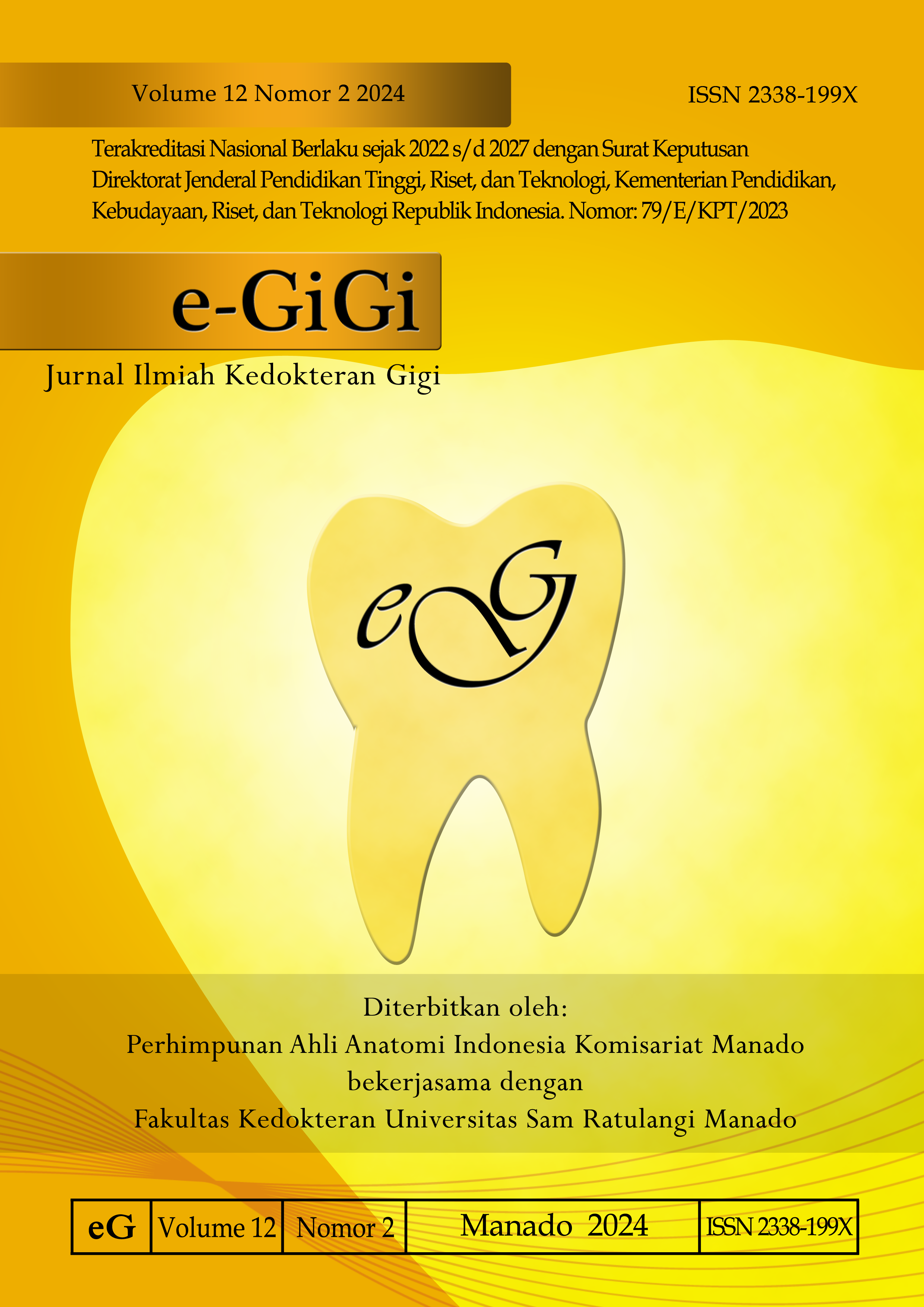Relationship between Tooth Brushing Behavior and Dental Caries in Children at 27 Sungai Sapih Public Elementary School Kuranji, Padang City
DOI:
https://doi.org/10.35790/eg.v12i2.48841Abstract
Caries is often experienced in mid-childhood (10-12 years) which is referred to as a vulnerable period, because at that time milk teeth begin to fall out and first permanent teeth begin to erupt. Tooth brushing is the most recommended primary prevention in maintaining dental and oral health. This study aimed to evaluate the relationship between tooth brushing behavior and dental caries in children at 27 Sungai Sapih Kuranji Public Elementary School, Padang City. This was a quantitative study with an analytical and observational approach. Population were all students in grades 4 and 5, totaling 114 students obtained with total sampling technique. Data were analyzed using the Spearman test, and were processed using computerized program SPSS IBM version 25.0. The results showed that most subjects had moderate tooth brushing behavior (82.5%), and the highest percentage of dental caries level was very low (49.1%). The Spearman test showed a significant relationship between tooth brushing behavior and dental caries level among the subjects (p=0.001). In conclusion, there was a significant relationship between tooth brushing behavior and dental caries in children at SD Negeri 27 Sungai Sapih Kuranji, Padang City. It is recommended for dental health workers to educate the students about the importance of dental and oral care and how to do tooth brushing properly and correctly.
Keywords: tooth brushing behavior; dental caries; elementary school children; dental and oral health
References
Mukhbitin F. Gambaran kejadian karies gigi pada siswa kelas 3 MI Al-Mutmainnah. Jurnal Promkes. 2015;6(2):155–66.
Yogie GS, So E. Hubungan kebiasaan menyikat gigi dengan karies pada siswa SD X di Jakarta Barat tahun 2019. Tarumanagara Medical Journal. 2020;2(2):277-81. Doi:10.24912/tmj.v3i1.9728
Sukarsih, Silfia A, Muliadi. Perilaku dan keterampilan menyikat gigi terhadap timbulnya karies gigi pada anak di Kota Jambi. Jurnal Kesehatan Gigi. 2019;6(2):80-6.
Andani M, Hardian R, Fadillah W, Putri VS, Maimaznah M. Penyuluhan kesehatan tentang karies gigi dan lomba gosok gigi di Wilayah RT 08 Kelurahan Murni. Jurnal Kesehatan Gigi. 2019;1(3):210-6.
AAG Agung, Dewi NKEP. Hubungan perilaku menyikat gigi dan karies gigi molar pertama permanen pada siswa kelas V di SDN 4 Pendem tahun 2018. Jurnal Kesehatan Gigi. 2019;6(2):5–8.
Lendrawati, Ervan D, Iryani D. Hubungan pemeliharaan kesehatan gigi dengan status karies gigi siswa kelas 1 SMP 1 Muhammadiyah Kecamatan Padang Timur Kota Padang. Andalas Dental Journal. 2015;3(1):1–9. Available from: https://doi.org/10.25077/adj.v3i1.30
Ayuningtyas G. Hubungan kebiasaan menggosok gigi dengan timbulnya karies gigi anak usia sekolah kelas 4 SDN Puspiptek Tangerang Selatan. Edu Dharma Journal. 2019;3(1):25-31.
Jumriani. Hubungan frekuensi menyikat gigi dengan tingkat kebersihan gigi dan mulut siswa SD Inpres BTN IKIP 1 Kota Makassar. Media Kesehatan Gigi. 2018;17(2):46–55. Doi: 10.32382/mkg.v17i2.706.
Ruslan, Jayanti. Hubungan antara perilaku manyikat gigi dengan tingkat kematangan plak gigi pada siswa Sekolah Dasar. Cakradonya Dental Journal. 2022;14(1):1-7. Doi:10.24815/cdj.v14i1.27294
Maryani E. Hubungan perilaku menggosok gigi dengan kejadian karies gigi pada anak kelas 1 dan 2 SD Tanggulrejo Kecamatan Tempuran Kabupaten Magelang [Skripsi]. Magelang: Universitas Muhammadiyah Magelang; 2019.
Saragih IR. Gambaran pola menyikat gigi dengan kejadian karies gigi pada anak Sekolah Dasar tahun 2021. Jurnal Poltekkes Medan. 2021;13:1–7. Available from: ecampus.poltekkes-medan.ac.id/jspui/ handle/123456789/5488?mode=full.
Prasada DGBD. Gambaran perilaku menggosok gigi pada siswa kelas I SD dengan karies gigi di wilayah kerja Puskesmas Rendang Karangasem Bali Oktober 2014. Intisari Sains Medis (ISM). 2016;6(1):23.
Wandini R., Yuniati Y. Konsumsi makanan kariogenik dan kebiasaan menggosok gigi dengan kejadian karies gigi pada anak. Holistik Jurnal Kesehatan. 2020;13(4):333–9. Doi:10.33024/hjk.v13i4.2091.
Downloads
Published
How to Cite
Issue
Section
License
Copyright (c) 2023 Sri P. Utami, Intan B. E. Mahata, Valendriyani Ningrum, Ricky Amran, Resi Wiyanti

This work is licensed under a Creative Commons Attribution-NonCommercial 4.0 International License.
COPYRIGHT
Authors who publish with this journal agree to the following terms:
Authors hold their copyright and grant this journal the privilege of first publication, with the work simultaneously licensed under a Creative Commons Attribution License that permits others to impart the work with an acknowledgment of the work's origin and initial publication by this journal.
Authors can enter into separate or additional contractual arrangements for the non-exclusive distribution of the journal's published version of the work (for example, post it to an institutional repository or publish it in a book), with an acknowledgment of its underlying publication in this journal.
Authors are permitted and encouraged to post their work online (for example, in institutional repositories or on their website) as it can lead to productive exchanges, as well as earlier and greater citation of the published work (See The Effect of Open Access).






